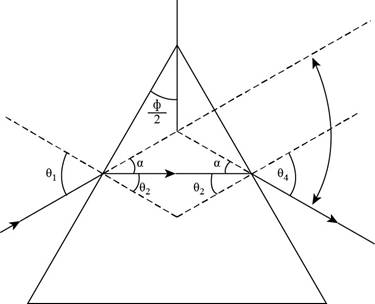
Concept explainers
(a)
To show: Light will pass symmetrically through the prism if the angle of incidence on the first surface
(a)
Answer to Problem 28P
The light will pass symmetrically through the prism, if the angle of incidence on the first surface
Explanation of Solution
Given information: The apex angle is
The diagram for the given condition is shown below.

Figure (1)
Apply Snell’s law of refraction at the first interface.
The Snell’s law of refraction is,
Here,
Substitute
Apply Snell’s law of refraction at the second interface.
The Snell’s law of refraction is,
Here,
Substitute
Since,
Conclusion:
Therefore, the light will pass symmetrically through the prism.
(b)
The angle of minimum deviation
(b)
Answer to Problem 28P
The angle of minimum deviation
Explanation of Solution
Given information: The apex angle is
The angle of minimum deviation
Here,
Substitute
Conclusion:
Therefore, the orientation angle in the proper frame is
(c)
The angle of minimum deviation
(c)
Answer to Problem 28P
The angle of minimum deviation
Explanation of Solution
Given information: The apex angle is
Apply Snell’s law of refraction at the first interface.
The Snell’s law of refraction is,
Here,
Substitute
Apply Snell’s law of refraction at the second interface.
The Snell’s law of refraction is,
Here,
Substitute
The angle of minimum deviation
Here,
Substitute
Conclusion:
Therefore, the orientation angle in the proper frame is
(d)
The angle of minimum deviation
(d)
Answer to Problem 28P
The angle of minimum deviation
Explanation of Solution
Given information: The apex angle is
Apply Snell’s law of refraction at the first interface.
The Snell’s law of refraction is,
Here,
Substitute
Apply Snell’s law of refraction at the second interface.
The Snell’s law of refraction is,
Here,
Substitute
The angle of minimum deviation
Here,
Substitute
Conclusion:
Therefore, the orientation angle in the proper frame is
Want to see more full solutions like this?
Chapter 35 Solutions
Physics For Scientists And Engineers With Modern Physics, 9th Edition, The Ohio State University
- Need help wity equilibrium qestionarrow_forwardneed answer asap please thanks youarrow_forwardA man slides two boxes up a slope. The two boxes A and B have a mass of 75 kg and 50 kg, respectively. (a) Draw the free body diagram (FBD) of the two crates. (b) Determine the tension in the cable that the man must exert to cause imminent movement from rest of the two boxes. Static friction coefficient USA = 0.25 HSB = 0.35 Kinetic friction coefficient HkA = 0.20 HkB = 0.25 M₁ = 75 kg MB = 50 kg P 35° Figure 3 B 200arrow_forward
- A golf ball is struck with a velocity of 20 m/s at point A as shown below (Figure 4). (a) Determine the distance "d" and the time of flight from A to B; (b) Determine the magnitude and the direction of the speed at which the ball strikes the ground at B. 10° V₁ = 20m/s 35º Figure 4 d Barrow_forwardThe rectangular loop of wire shown in the figure (Figure 1) has a mass of 0.18 g per centimeter of length and is pivoted about side ab on a frictionless axis. The current in the wire is 8.5 A in the direction shown. Find the magnitude of the magnetic field parallel to the y-axis that will cause the loop to swing up until its plane makes an angle of 30.0 ∘ with the yz-plane. Find the direction of the magnetic field parallel to the y-axis that will cause the loop to swing up until its plane makes an angle of 30.0 ∘ with the yz-plane.arrow_forwardA particle with a charge of − 5.20 nC is moving in a uniform magnetic field of (B→=−( 1.22 T )k^. The magnetic force on the particle is measured to be (F→=−( 3.50×10−7 N )i^+( 7.60×10−7 N )j^. Calculate the y and z component of the velocity of the particle.arrow_forward
 College PhysicsPhysicsISBN:9781285737027Author:Raymond A. Serway, Chris VuillePublisher:Cengage Learning
College PhysicsPhysicsISBN:9781285737027Author:Raymond A. Serway, Chris VuillePublisher:Cengage Learning College PhysicsPhysicsISBN:9781305952300Author:Raymond A. Serway, Chris VuillePublisher:Cengage Learning
College PhysicsPhysicsISBN:9781305952300Author:Raymond A. Serway, Chris VuillePublisher:Cengage Learning Physics for Scientists and EngineersPhysicsISBN:9781337553278Author:Raymond A. Serway, John W. JewettPublisher:Cengage Learning
Physics for Scientists and EngineersPhysicsISBN:9781337553278Author:Raymond A. Serway, John W. JewettPublisher:Cengage Learning Physics for Scientists and Engineers with Modern ...PhysicsISBN:9781337553292Author:Raymond A. Serway, John W. JewettPublisher:Cengage Learning
Physics for Scientists and Engineers with Modern ...PhysicsISBN:9781337553292Author:Raymond A. Serway, John W. JewettPublisher:Cengage Learning Physics for Scientists and Engineers: Foundations...PhysicsISBN:9781133939146Author:Katz, Debora M.Publisher:Cengage Learning
Physics for Scientists and Engineers: Foundations...PhysicsISBN:9781133939146Author:Katz, Debora M.Publisher:Cengage Learning Physics for Scientists and Engineers, Technology ...PhysicsISBN:9781305116399Author:Raymond A. Serway, John W. JewettPublisher:Cengage Learning
Physics for Scientists and Engineers, Technology ...PhysicsISBN:9781305116399Author:Raymond A. Serway, John W. JewettPublisher:Cengage Learning





